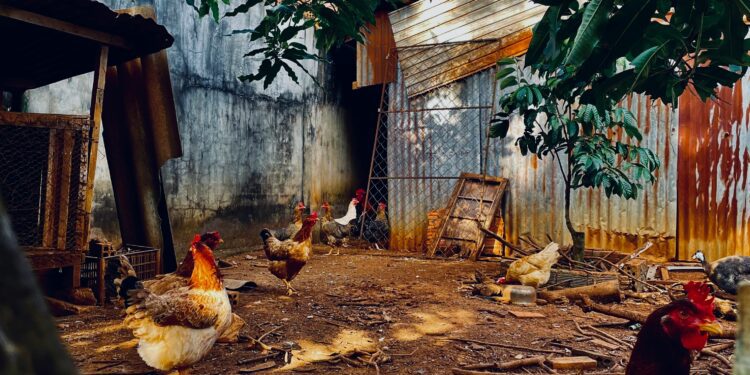The Surprise Nobody Wanted
The telephone rang in Brasília at 3:38 a.m. on May 16. By dawn, agriculture-ministry officials had confirmed what Brazilian veterinarians had feared for two decades: a highly pathogenic H5N1 strain was ripping through laying hens on a farm outside Montenegro, Rio Grande do Sul. Within twelve hours Mexico, Chile, Uruguay, Argentina, and the European Union announced partial or full embargoes on Brazilian poultry. Chicken futures spiked in Chicago, São Paulo traders fielded panicked calls from Chinese buyers, and Google searches for “bird flu Brazil” rocketed more than four-hundred percent. ReutersU.S. News & World Report
Brazil is no stranger to disease containment drills, but this was its first commercial-flock breach. Previous detections, all in wild birds along the Atlantic flyway, had been presented as proof that the country’s billion-dollar biosecurity investments were working. That narrative shattered in a single sunrise.
Brazil’s Poultry Paradox
Brazil supplies roughly one-third of the world’s chicken exports and employs 4.1 million people in poultry and downstream industries. In 2024 the sector generated $10.3 billion in foreign revenue and funded much of the nation’s rural credit programs. Yet that very success created a structural vulnerability: concentrated, vertically integrated systems mean that a localized outbreak can deliver a macro-economic shock in real time.
Unlike the United States or China, Brazil had never culled a commercial flock for bird flu. Its risk calculus was based on geography (tropical climate, fewer migratory waterfowl), bio-isolation (mandatory truck disinfection zones, two-meter dead-zone buffers), and aggressive vaccination of staff against seasonal influenza to avoid co-infection. But H5N1 has rewritten the rules, showing an uncanny knack for crossing species barriers and surviving in warm, humid conditions once regarded as hostile. Reuters
Anatomy of the Outbreak
Ground zero was a 17,000-bird layer house owned by Vibra Foods, a Tyson-linked subsidiary. Farmers noticed sudden lethargy and neurological tremors; mortality jumped to twenty-five percent overnight. State veterinarians dispatched polymerase-chain-reaction test kits, and by midday the National Agricultural Laboratory had a positive HPAI result. Authorities erected sanitary barriers, blocked rural roads, and began culling adjacent sheds. The state later reported 15,000 dead birds and 2,000 preventive culls, plus the destruction of 1.7 million fertilized eggs to avoid downstream hatchery contamination. Reuters
The epidemiological puzzle centers on how the virus breached strict perimeter fencing. Preliminary genomic sequencing indicates a clade 2.3.4.4b lineage, nearly identical to strains circulating in Andean terns off Argentina’s coast earlier this year. Ornithologists suspect that cape petrels and kelp gulls migrating northward used grain silos and water troughs as rest stops, contaminating feed. That hypothesis, if confirmed, would upend Brazil’s reliance on indoor confinement as a silver bullet.
The Political Optics of Containment
Agriculture Minister Carlos Fávaro convened a televised press briefing, insisting that “a blanket ban on Brazilian poultry is unnecessary and unlikely.” Behind the scenes, diplomats scrambled to reassure China (Brazil’s biggest buyer) that compartmentalization protocols would ring-fence the outbreak. Yet the optics were grim: photographs of yellow-suited crews dragging black plastic bags of hens went viral on X, captioned “Dead birds, dead exports.” Reuters
International trade law complicates Brazil’s response. Under World Organisation for Animal Health (WOAH) rules, a country can regain disease-free status only 28 days after the last disinfection of the last infected premises. With weekly export volumes of 220,000 tons, each lost day bleeds cash. The ministry is negotiating “regionalization” deals—allowing imports from unaffected states—but many buyers prefer to hit the pause button rather than navigate paperwork. Argentina’s Senasa regulator, for instance, announced a total suspension of Brazilian poultry imports on the same day the outbreak was reported. Reuters
Supply-Chain Reverberations
The first casualties appeared far from Brazil’s borders. South African retailers raised shelf prices by seven percent within forty-eight hours; Gulf Cooperation Council countries opened emergency tenders to Ukraine and Thailand; U.S. soybean crushers braced for a short-term dip in Brazilian feed demand. Commodity analysts at Rabobank warned that, if the bans linger through July, global chicken prices could rise 12–18 percent, exacerbating food-inflation pressures already fueled by grain market volatility.
Financial markets responded in kind: JBS SA shares fell 5.6 percent on B3; meanwhile vaccine maker Zoetis gained 3.1 percent on the NYSE as investors bet on accelerated demand for avian-flu immunogens. Hedge funds, recalling the 2022 H5N1 surge that wiped out 58 million U.S. birds, started amassing call options on chilled-poultry exporters in Southeast Asia.
One Health on Trial
Beyond commerce lies the specter of zoonotic spillover. H5N1’s recent forays into **mammalian hosts—dairy cattle in the United States, sea lions in Peru, cats in Europe—**underscore a viral adaptability that defies earlier textbooks. Brazilian public-health officials have screened 48 farmworkers; all tests are negative so far, but the incident reignites debate over whether vaccinating poultry could inadvertently mask human-health warning signs.
WOAH historically discouraged vaccination because it complicates surveillance, but a growing coalition of veterinarians and virologists argues that modern DIVA (Differentiating Infected from Vaccinated Animals) tools solve that dilemma. China vaccinates aggressively, and France began a nationwide duck program in 2023. Brazil’s outbreak may push other exporters— notably the United States and Thailand—toward preventive vaccination, setting up a policy schism between prophylaxis and purity.
Climate Cross-Currents
Climate change hangs over the narrative like a stubborn low-pressure system. Warmer winters and altered migratory routes are forcing waterfowl into new ecological niches, bringing novel viral lineages into contact with high-density farms from Arkansas to the Amazon basin. A study in Nature Climate Change last year projected a 31 percent increase in avian-flu transmission risk zones by 2050 under a mid-range emissions scenario. The Brazil outbreak offers a case study in how ecological feedback loops, trade interdependence, and policy lag can fuse into what complexity theorists call a “tightly coupled system.”
What Comes Next
Brazil has mobilized more than 200 federal inspectors and is running daily PCR screenings on 524 neighboring properties. If no new positives emerge by early June, the export bans could lift well before the 28-day mark under bilateral waiver clauses. But the episode’s psychological scar may outlast the virus itself, reinforcing consumer unease about industrial husbandry and emboldening regulators to scrutinize long shipping chains that treat fresh meat like fungible widgets.
For multinational food companies, the message is blunt: concentration equals fragility. Diversification—across geographies, species, and cold-chain technologies—looks less like strategic fluff and more like existential risk management. Investors betting on single-country dominance now face a pathogen that can travel in an egret’s feather and erase profit margins overnight.
The Broader Lesson
H5N1’s arrival in Brazil is not merely a veterinary event; it is a mirror held up to a global food system that prizes efficiency over redundancy. As epidemiologists like to remind us, “nature bats last.” Whether the outbreak remains a tragic footnote or heralds a new era of protein geopolitics depends on how quickly policymakers, industry, and civil society can pivot from reactive containment to proactive resilience.
In that sense, the true story is not about a farm in Rio Grande do Sul but about the tightrope we all walk between nourishment and novelty, commerce and contagion. The virus may have found a gap in Brazil’s defenses, but it also exposed gaps in our collective imagination. Filling them will require the unglamorous work of stitching veterinary data, climate models, and trade diplomacy into a durable safety net—before the next wing-beat brings the next surprise.















